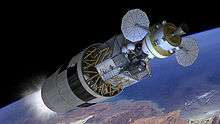Trans-lunar injection

A trans-lunar injection (TLI) is a propulsive maneuver used to set a spacecraft on a trajectory that will cause it to arrive at the Moon.
Typical lunar transfer trajectories approximate Hohmann transfers, although low-energy transfers have also been used in some cases, as with the Hiten probe.[1] For short duration missions without significant perturbations from sources outside the Earth-Moon system, a fast Hohmann transfer is typically more practical.
A spacecraft performs TLI to begin a lunar transfer from a low circular parking orbit around Earth. The large TLI burn, usually performed by a chemical rocket engine, increases the spacecraft's velocity, changing its orbit from a circular low Earth orbit to a highly eccentric orbit. As the spacecraft begins coasting on the lunar transfer arc, its trajectory approximates an elliptical orbit about the Earth with an apogee near to the radius of the Moon's orbit. The TLI burn is sized and timed to precisely target the Moon as it revolves around the Earth. The burn is timed so that the spacecraft nears apogee as the Moon approaches. Finally, the spacecraft enters the Moon's sphere of influence, making a hyperbolic lunar swingby.
Modeling

Patched conics
TLI targeting and lunar transfers are a specific application of the n body problem, which may be approximated in various ways. The simplest way to explore lunar transfer trajectories is by the method of patched conics. The spacecraft is assumed to accelerate only under classical 2 body dynamics, being dominated by the Earth until it reaches the Moon's sphere of influence. Motion in a patched-conic system is deterministic and simple to calculate, lending itself for rough mission design and "back of the envelope" studies.
Restricted circular three body (RC3B)
More realistically, however, the spacecraft is subject to gravitational forces from many bodies. Gravitation from Earth and Moon dominate the spacecraft's acceleration, and since the spacecraft's own mass is negligible in comparison, the spacecraft's trajectory may be better approximated as a restricted three-body problem. This model is a closer approximation but lacks an analytic solution,[2] requiring numerical calculation via methods such as Runge-Kutta.[3]
Further accuracy
More detailed simulation involves modeling the Moon's true orbital motion; gravitation from other astronomical bodies; the non-uniformity of the Earth's and Moon's gravity; including solar radiation pressure; and so on. Propagating spacecraft motion in such a model is numerically intensive, but necessary for true mission accuracy.
Free return
In some cases it is possible to design a TLI to target a free return trajectory, so that the spacecraft will loop around behind the Moon and return to Earth without need for further propulsive maneuvers.[4] Such free return trajectories add a margin of safety to human spaceflight missions, since the spacecraft will return to Earth "for free" after the initial TLI burn.
History
The first space probe to successfully perform TLI was the Soviet Union's Luna 1 on January 2, 1959. The first human-crewed mission to successfully perform this procedure, and thus becoming the first humans to leave the Earth's influence, was Apollo 8 on December 21, 1968.
For the Apollo lunar missions, the restartable J-2 engine in the third (S-IVB) stage of the Saturn V rocket performed TLI. This particular TLI burn lasted approximately 350 seconds, providing 3.05 to 3.25 km/s (10,000 to 10,600 ft/s) of delta-v, at which point the spacecraft was traveling at approximately 10.4 km/s (34150 ft/s) relative to the Earth.[5] The Apollo 8 TLI was spectacularly observed from the Hawaiian Islands in the pre-dawn sky south of Waikiki, photographed and reported in the papers the next day.[6] In 1969, the Apollo 10 pre-dawn TLI was visible from Cloncurry, Australia.[7] It was described as resembling car headlights coming over a hill in fog, with the spacecraft appearing as a bright comet with a greenish tinge.[7]
See also
- Trans-Earth injection
- Trans-Mars injection
- Low energy transfer
- Astrodynamics
- Comparison of super heavy lift launch systems
References
- ↑ "Hiten". NASA.
- ↑ Henri Poincaré, Les Méthodes Nouvelles de Mécanique Céleste, Paris, Gauthier-Villars et fils, 1892-99.
- ↑ Victor Szebehely, Theory of Orbits, The Restricted Problem of Three Bodies, Yale University, Academic Press, 1967.
- ↑ Schwaninger, Arthur J. (1963). Trajectories in the Earth-Moon Space with Symmetrical Free Return Properties (PDF). Technical Note D-1833. Huntsville, Alabama: NASA / Marshall Space Flight Center.
- ↑ "Apollo By the Numbers". NASA. Archived from the original on 2004-11-18.
- ↑ "Independent Star News, Sunday, December 22, 1968". "The TLI firing was begun at PST while the craft was over Hawaii and it was reported there that the burn was visible from the ground."
- 1 2 French, Francis; Colin Burgess (2007). In the Shadow of the Moon. University of Nebraska Press. p. 372. ISBN 978-0-8032-1128-5.
![]() This article incorporates public domain material from websites or documents of the National Aeronautics and Space Administration.
This article incorporates public domain material from websites or documents of the National Aeronautics and Space Administration.